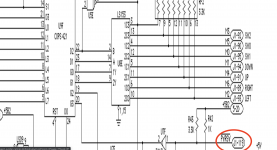Hi all,
Sorry to keep bring up my 2/5 saga but I think I may have found out what is wrong. Spoiler alert: I have no idea what I am doing so everything that follows this sentence is said with a deal of uncertainty. Unfortunately my area of speciality isn't electronics (as much as I would like it to be) so most of this was just me guessing.
So I was looking at Lisa 1 I/O board schematics and noticed the following:
1. PWRSW sounds a lot like an abbreviation of power switch
2. J1 - 119 sounds like connector 1 on the motherboard pin 119
3. PWRSW utilises pin 119 as shown by the schematics
So since my Lisa starts up automatically without receiving a press from the power switch I assumed that there was a problem somewhere along anything in contact with pin 119. Turns out I get no continuity between the two red arrows on the I/O board. A simple pin path but one that is closest to the location of the battery leakage. So if 1-3 are correct and the previous sentence is correct, do you think patching this trace will start my Lisa up when the switch is pressed. In a hypothetical situation, if you were to cut that trace on a working board would that manifest as a Lisa that turns on without the soft switch being pressed. If the answer is yes then I may have the solution to my problem.
Regards,
Max


Sorry to keep bring up my 2/5 saga but I think I may have found out what is wrong. Spoiler alert: I have no idea what I am doing so everything that follows this sentence is said with a deal of uncertainty. Unfortunately my area of speciality isn't electronics (as much as I would like it to be) so most of this was just me guessing.
So I was looking at Lisa 1 I/O board schematics and noticed the following:
1. PWRSW sounds a lot like an abbreviation of power switch
2. J1 - 119 sounds like connector 1 on the motherboard pin 119
3. PWRSW utilises pin 119 as shown by the schematics
So since my Lisa starts up automatically without receiving a press from the power switch I assumed that there was a problem somewhere along anything in contact with pin 119. Turns out I get no continuity between the two red arrows on the I/O board. A simple pin path but one that is closest to the location of the battery leakage. So if 1-3 are correct and the previous sentence is correct, do you think patching this trace will start my Lisa up when the switch is pressed. In a hypothetical situation, if you were to cut that trace on a working board would that manifest as a Lisa that turns on without the soft switch being pressed. If the answer is yes then I may have the solution to my problem.
Regards,
Max




